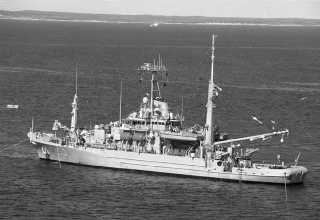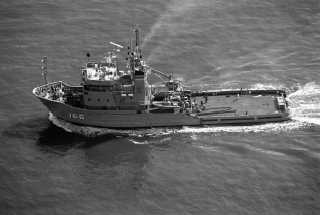replenish outlying units of the force with dry cargo and
ammunition.
The missile and special weapons-handling system
is separate from the cargo-handling system. This
arrangement permits a continuous flow of missiles from
the cargo holds to the missile-transfer system, port or
starboard.
The fuel hoses on the AOE are designed to permit an
average ship separation of 200 feet during
replenishment instead of the normal 100 feet. The
greater distance reduces the possibility of collision and
makes increased replenishment speeds feasible. There
are nine replenishment stations to port and six to
starboard.
FLEET SUPPORT SHIPS.—While certain types
of naval auxiliary ships are designed and equipped
specifically for towing, for salvage, or for rescue
operations, most of these types may, in an emergency
and to a limited extent, perform all these operations.
Among ships as versatile and as adaptable as the
auxiliaries, there is bound to be an occasional
overlapping of functions to meet an unexpected
situation.
Rescue and Salvage Ships.—The mission of the
rescue and salvage ship (ARS) has four
parts—debeaching stranded vessels, heavy lift
capability from ocean depths, towing other vessels, and
manned diving operations. For rescue missions, these
ships are equipped with fire monitors forward and
amidships, which can deliver either fire-fighting foam
or seawater. The salvage holds of these ships are
outfitted with portable equipment to provide assistance
to other vessels in dewatering, patching, and supplying
of electrical power and other essential services required
to return a disabled ship to an operating condition.
The Navy employs ARSs (fig. 8-37) to salvage U.S.
government-owned ships and, when it is in the best
interests of the United States, privately owned vessels.
The rugged construction of these steel-hulled ships,
combined with speed and endurance, make rescue and
salvage ships well suited for rescue/salvage operations
of Navy and commercial shipping throughout the world.
The versatility of this class of ship adds to the
capabilities of the U.S. Navy with regard to assisting
those in need on the high seas.
Oceangoing Tugs.—There is one major type of
oceangoing tug—the ATF (fleet ocean tug) (fig. 8-38).
It has a large cruising range and limited salvage
capabilities. ATFs are equipped with firefighting
equipment, including fire monitors. (A fire monitor is
similar in appearance to a gun and permits water to be
discharged through a horizontal arc of 360°.) They also
are fitted with automatic towing machines and booms.
In addition to hauling and towing, fleet tugs may be
called on to patrol certain areas, lay smoke screens, and
pull landing craft off beaches. They are often used in
search and rescue (SAR) operations. Military Sealift
Command (MSC) personnel now operate most fleet
tugs.
8-31
Student Notes:
Photograph courtesy of PH1 Todd P. Cichonowicz
Figure 8-37.—USS Grapple (ARS-53).
Photograph courtesy of Robert J. Sitar
Figure 8-38.—USNS Powhaten (T-ATF-166).




